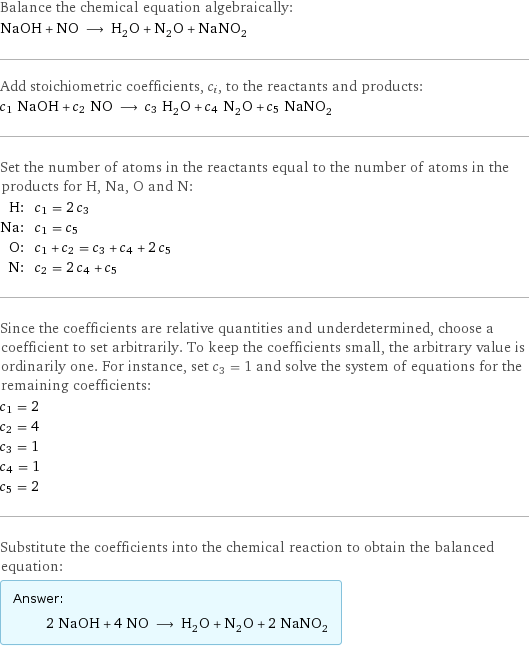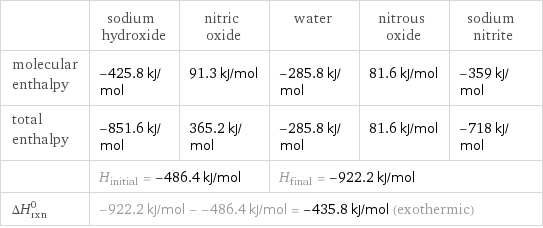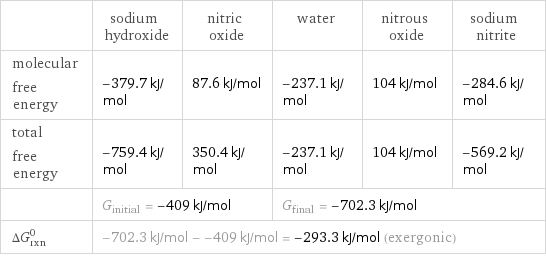Input interpretation

NaOH sodium hydroxide + NO nitric oxide ⟶ H_2O water + N_2O nitrous oxide + NaNO_2 sodium nitrite
Balanced equation

Balance the chemical equation algebraically: NaOH + NO ⟶ H_2O + N_2O + NaNO_2 Add stoichiometric coefficients, c_i, to the reactants and products: c_1 NaOH + c_2 NO ⟶ c_3 H_2O + c_4 N_2O + c_5 NaNO_2 Set the number of atoms in the reactants equal to the number of atoms in the products for H, Na, O and N: H: | c_1 = 2 c_3 Na: | c_1 = c_5 O: | c_1 + c_2 = c_3 + c_4 + 2 c_5 N: | c_2 = 2 c_4 + c_5 Since the coefficients are relative quantities and underdetermined, choose a coefficient to set arbitrarily. To keep the coefficients small, the arbitrary value is ordinarily one. For instance, set c_3 = 1 and solve the system of equations for the remaining coefficients: c_1 = 2 c_2 = 4 c_3 = 1 c_4 = 1 c_5 = 2 Substitute the coefficients into the chemical reaction to obtain the balanced equation: Answer: | | 2 NaOH + 4 NO ⟶ H_2O + N_2O + 2 NaNO_2
Structures

+ ⟶ + +
Names

sodium hydroxide + nitric oxide ⟶ water + nitrous oxide + sodium nitrite
Reaction thermodynamics
Enthalpy

| sodium hydroxide | nitric oxide | water | nitrous oxide | sodium nitrite molecular enthalpy | -425.8 kJ/mol | 91.3 kJ/mol | -285.8 kJ/mol | 81.6 kJ/mol | -359 kJ/mol total enthalpy | -851.6 kJ/mol | 365.2 kJ/mol | -285.8 kJ/mol | 81.6 kJ/mol | -718 kJ/mol | H_initial = -486.4 kJ/mol | | H_final = -922.2 kJ/mol | | ΔH_rxn^0 | -922.2 kJ/mol - -486.4 kJ/mol = -435.8 kJ/mol (exothermic) | | | |
Gibbs free energy

| sodium hydroxide | nitric oxide | water | nitrous oxide | sodium nitrite molecular free energy | -379.7 kJ/mol | 87.6 kJ/mol | -237.1 kJ/mol | 104 kJ/mol | -284.6 kJ/mol total free energy | -759.4 kJ/mol | 350.4 kJ/mol | -237.1 kJ/mol | 104 kJ/mol | -569.2 kJ/mol | G_initial = -409 kJ/mol | | G_final = -702.3 kJ/mol | | ΔG_rxn^0 | -702.3 kJ/mol - -409 kJ/mol = -293.3 kJ/mol (exergonic) | | | |
Equilibrium constant
![Construct the equilibrium constant, K, expression for: NaOH + NO ⟶ H_2O + N_2O + NaNO_2 Plan: • Balance the chemical equation. • Determine the stoichiometric numbers. • Assemble the activity expression for each chemical species. • Use the activity expressions to build the equilibrium constant expression. Write the balanced chemical equation: 2 NaOH + 4 NO ⟶ H_2O + N_2O + 2 NaNO_2 Assign stoichiometric numbers, ν_i, using the stoichiometric coefficients, c_i, from the balanced chemical equation in the following manner: ν_i = -c_i for reactants and ν_i = c_i for products: chemical species | c_i | ν_i NaOH | 2 | -2 NO | 4 | -4 H_2O | 1 | 1 N_2O | 1 | 1 NaNO_2 | 2 | 2 Assemble the activity expressions accounting for the state of matter and ν_i: chemical species | c_i | ν_i | activity expression NaOH | 2 | -2 | ([NaOH])^(-2) NO | 4 | -4 | ([NO])^(-4) H_2O | 1 | 1 | [H2O] N_2O | 1 | 1 | [N2O] NaNO_2 | 2 | 2 | ([NaNO2])^2 The equilibrium constant symbol in the concentration basis is: K_c Mulitply the activity expressions to arrive at the K_c expression: Answer: | | K_c = ([NaOH])^(-2) ([NO])^(-4) [H2O] [N2O] ([NaNO2])^2 = ([H2O] [N2O] ([NaNO2])^2)/(([NaOH])^2 ([NO])^4)](../image_source/5eb3218d4cd9eedbabd18b5964cbded7.png)
Construct the equilibrium constant, K, expression for: NaOH + NO ⟶ H_2O + N_2O + NaNO_2 Plan: • Balance the chemical equation. • Determine the stoichiometric numbers. • Assemble the activity expression for each chemical species. • Use the activity expressions to build the equilibrium constant expression. Write the balanced chemical equation: 2 NaOH + 4 NO ⟶ H_2O + N_2O + 2 NaNO_2 Assign stoichiometric numbers, ν_i, using the stoichiometric coefficients, c_i, from the balanced chemical equation in the following manner: ν_i = -c_i for reactants and ν_i = c_i for products: chemical species | c_i | ν_i NaOH | 2 | -2 NO | 4 | -4 H_2O | 1 | 1 N_2O | 1 | 1 NaNO_2 | 2 | 2 Assemble the activity expressions accounting for the state of matter and ν_i: chemical species | c_i | ν_i | activity expression NaOH | 2 | -2 | ([NaOH])^(-2) NO | 4 | -4 | ([NO])^(-4) H_2O | 1 | 1 | [H2O] N_2O | 1 | 1 | [N2O] NaNO_2 | 2 | 2 | ([NaNO2])^2 The equilibrium constant symbol in the concentration basis is: K_c Mulitply the activity expressions to arrive at the K_c expression: Answer: | | K_c = ([NaOH])^(-2) ([NO])^(-4) [H2O] [N2O] ([NaNO2])^2 = ([H2O] [N2O] ([NaNO2])^2)/(([NaOH])^2 ([NO])^4)
Rate of reaction
![Construct the rate of reaction expression for: NaOH + NO ⟶ H_2O + N_2O + NaNO_2 Plan: • Balance the chemical equation. • Determine the stoichiometric numbers. • Assemble the rate term for each chemical species. • Write the rate of reaction expression. Write the balanced chemical equation: 2 NaOH + 4 NO ⟶ H_2O + N_2O + 2 NaNO_2 Assign stoichiometric numbers, ν_i, using the stoichiometric coefficients, c_i, from the balanced chemical equation in the following manner: ν_i = -c_i for reactants and ν_i = c_i for products: chemical species | c_i | ν_i NaOH | 2 | -2 NO | 4 | -4 H_2O | 1 | 1 N_2O | 1 | 1 NaNO_2 | 2 | 2 The rate term for each chemical species, B_i, is 1/ν_i(Δ[B_i])/(Δt) where [B_i] is the amount concentration and t is time: chemical species | c_i | ν_i | rate term NaOH | 2 | -2 | -1/2 (Δ[NaOH])/(Δt) NO | 4 | -4 | -1/4 (Δ[NO])/(Δt) H_2O | 1 | 1 | (Δ[H2O])/(Δt) N_2O | 1 | 1 | (Δ[N2O])/(Δt) NaNO_2 | 2 | 2 | 1/2 (Δ[NaNO2])/(Δt) (for infinitesimal rate of change, replace Δ with d) Set the rate terms equal to each other to arrive at the rate expression: Answer: | | rate = -1/2 (Δ[NaOH])/(Δt) = -1/4 (Δ[NO])/(Δt) = (Δ[H2O])/(Δt) = (Δ[N2O])/(Δt) = 1/2 (Δ[NaNO2])/(Δt) (assuming constant volume and no accumulation of intermediates or side products)](../image_source/16259165d9b47840dca3f8800f7ff364.png)
Construct the rate of reaction expression for: NaOH + NO ⟶ H_2O + N_2O + NaNO_2 Plan: • Balance the chemical equation. • Determine the stoichiometric numbers. • Assemble the rate term for each chemical species. • Write the rate of reaction expression. Write the balanced chemical equation: 2 NaOH + 4 NO ⟶ H_2O + N_2O + 2 NaNO_2 Assign stoichiometric numbers, ν_i, using the stoichiometric coefficients, c_i, from the balanced chemical equation in the following manner: ν_i = -c_i for reactants and ν_i = c_i for products: chemical species | c_i | ν_i NaOH | 2 | -2 NO | 4 | -4 H_2O | 1 | 1 N_2O | 1 | 1 NaNO_2 | 2 | 2 The rate term for each chemical species, B_i, is 1/ν_i(Δ[B_i])/(Δt) where [B_i] is the amount concentration and t is time: chemical species | c_i | ν_i | rate term NaOH | 2 | -2 | -1/2 (Δ[NaOH])/(Δt) NO | 4 | -4 | -1/4 (Δ[NO])/(Δt) H_2O | 1 | 1 | (Δ[H2O])/(Δt) N_2O | 1 | 1 | (Δ[N2O])/(Δt) NaNO_2 | 2 | 2 | 1/2 (Δ[NaNO2])/(Δt) (for infinitesimal rate of change, replace Δ with d) Set the rate terms equal to each other to arrive at the rate expression: Answer: | | rate = -1/2 (Δ[NaOH])/(Δt) = -1/4 (Δ[NO])/(Δt) = (Δ[H2O])/(Δt) = (Δ[N2O])/(Δt) = 1/2 (Δ[NaNO2])/(Δt) (assuming constant volume and no accumulation of intermediates or side products)
Chemical names and formulas

| sodium hydroxide | nitric oxide | water | nitrous oxide | sodium nitrite formula | NaOH | NO | H_2O | N_2O | NaNO_2 Hill formula | HNaO | NO | H_2O | N_2O | NNaO_2 name | sodium hydroxide | nitric oxide | water | nitrous oxide | sodium nitrite